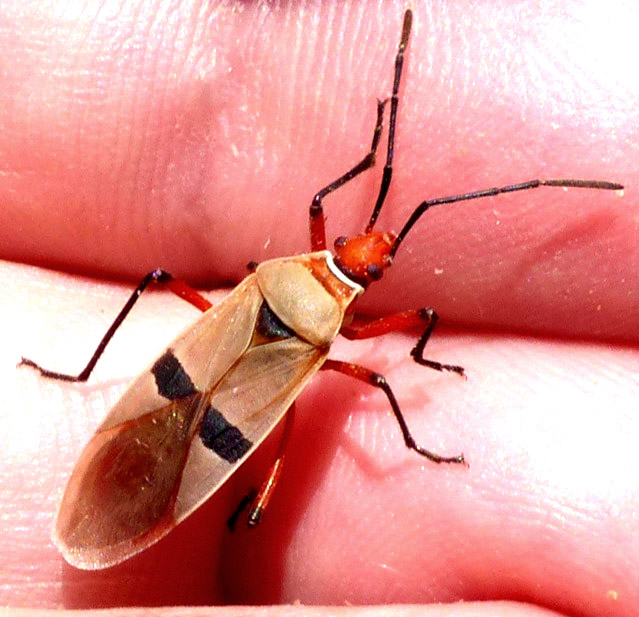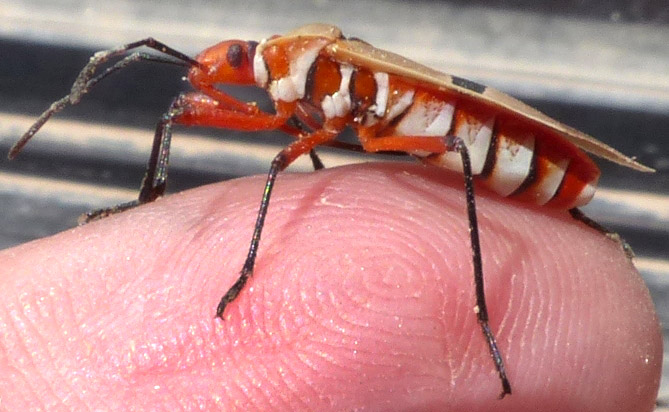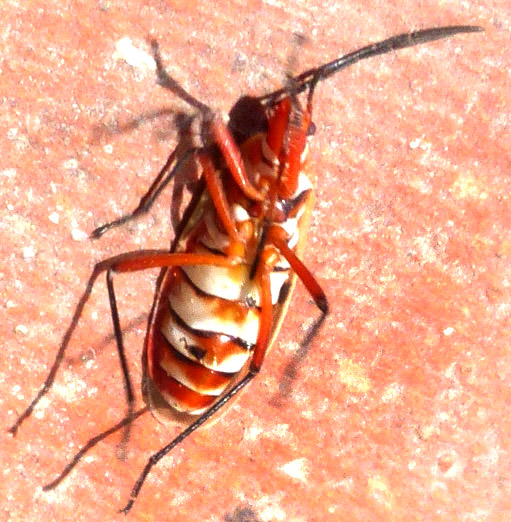Excerpts from Jim Conrad's
Naturalist Newsletter
Entry dated April 14, 2024, issued from near Tequisquiapan; elevation about 1,900m, (6200 ft), ~N20.57°, ~W99.89°; Querétaro state, MÉXICO
TWO-SPOTTED COTTON STAINER

Inside a walled-in courtyard at the edge of a small village and a minute's walk from semiarid scrub, the above bug floated in a dog's water dish. At first the bug seemed dead, but eventually it began moving around. With four wings, of which the back pair were partly covered by the thicker-textured front pair, it was clear that this was truly a member of the True Bug Order, the Hemiptera.

From the side, striking orange and white patterns were apparent, as well as the bug's strawlike proboscis tilted up beneath the head.


Above, the by-now squirming bug showed its undersurface. At the right, an image of the wing venation is modified to make clearer the back wing's distinctive branching pattern, which can confirm the species' identification.
Already I had an idea where to look on the True Bug branch of the Tree of Life for the identity of this bug, for back in the Yucatan I'd met such a flattish one with bright colors and small compound eyes on a neckless head; it had been one of several species called cotton stainers. That bug had belonged to the big genus Dysdercus, and in this area several Dysdercus species had been documented. Internet images of those species revealed two almost identical taxa which our bug could be: Dysdercus bimaculatus and Dysdercus obliquus.
In P.H. Doesberg's 1968 study "A revision of the New World species of Dysdercus Guerin Meneville (Heteroptera, Pyrrhocoridae)," it's stated that the two species are primarily distinguished by dissection to see their genitalia. However, maps in that study indicate that D. bimaculatus tends to live in more arid places, like the US state of Arizona and in western Texas, while D. obliquus is more to be expected in Texas's relatively lusher Lower Rio Grande Valley. Since here we're more like Arizona than along the lower Rio Grande, plus our individual shows more color contrast than most pictures of D. obliquus, and because in our area D. bimaculatus is much more frequently documented than D. obliquus, I'm filing this page under DYSDERCUS BIMACULATUS, which often is referred to as the Two-spotted Cotton Stainer.
Two-spotted Cotton Stainers occur from the arid southwestern US south through Mexico and Central America into northwestern South America. For the 2023 study by Richard Zack and others entitled "The Cotton Stainers (Hemiptera: Heteroptera: Pyrrhocoridae) of Guatemala," cotton stainer species were collected, mostly by using light traps. Our Dysdercus bimaculatus was their most commonly collected species, with Dysdercus obliquus being caught in much fewer numbers.
In the 2014 study by Atsiry Yareli López Fabila entitled "Dinámica ecológica y evolutiva de las especies del género Dysdercus presentes en las metapoblaciones de Gossypium hirsutum," it's said that Dysdercus bimaculatus obtains water from seeds and vegetation, as well as from the bodies of other insects, including those of its own species. It's also reported that the species feeds on sunflowers and several members of the Hibiscus Family, one of them being cotton plants.
The 1980 study by Janice A. Derr entitled "Coevolution of the Life History of a Tropical Seed-Feeding Insect and its Food Plants," looked at the life cycle of Dysdercus bimaculatus in Costa Rica and Panama. She found that the bug's immature nymph stages fed on seeds of four tree species, all members of the Hibiscus Family producing oily, energy-rich seeds. The nymphs, being wingless, had to survive where their eggs had been deposited. The adults migrated when food wasn't available, or went into diapause, which is a period of an animal's suspended development similar to hibernation -- simply close down and wait for food to become available. Other authors say that, while our bug does feed on cotton seeds, its damage isn't significant in cotton fields.